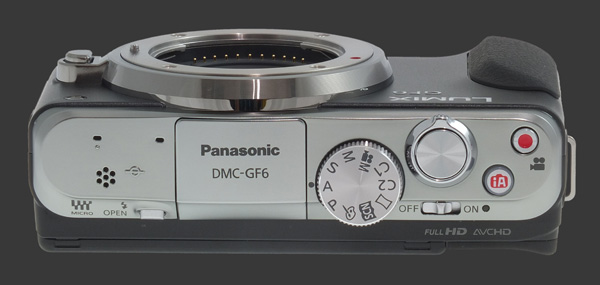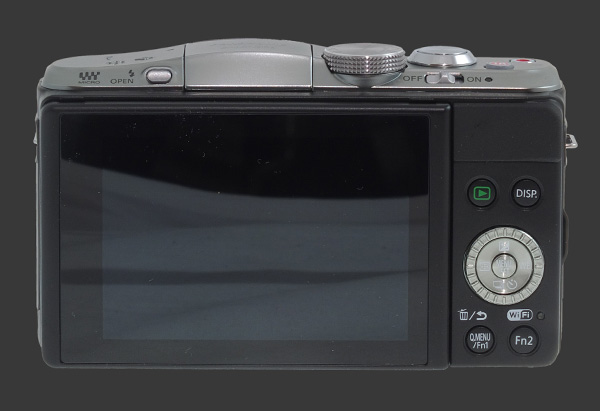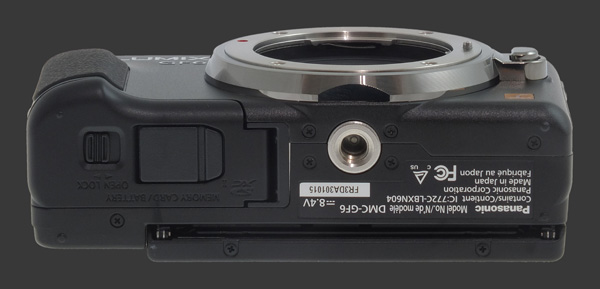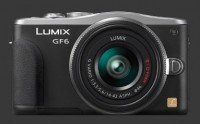Panasonic Lumix DMC-GF6 Review
Panasonic Lumix DMC-GF6 Introduction
The Panasonic Lumix DMC-GF6 is the company's latest compact mirrorless camera. It uses a 16 MP LiveMOS Micro Four-Thirds sensor with a sensitivity range from ISO 160 to 25600. It can record full 1080p HD video at 30 FPS and images at 4.2 FPS.
The GF6 aims to please novice photographers with a simple interface resembling that of a compact digital camera. Like all current mirrorless, the GF6 still offers full manual-controls, including manual-focus, custom white-balance and usual metering modes. It also includes a highly flexible autofocus system and manual controls for video.
The Panasonic GF6 gained a little bulk compared to its predecessor as it adds a tilting 3" LCD display which flips 180° vertically for self-portraits and built-in WiFi plus NFC to share images wirelessly.
Its lens mount makes the GF6 compatible with a growing number of Micro Four-Thirds lenses which are often designed for compactness. A number of those from Panasonic feature Optical Image Stabilization which is useful to compensate for camera shake on mirrorless cameras like this one which do not have built-in stabilization.
This digital camera review analyses the usability, image quality and performance of the Panasonic Lumix DMC-GF6.
Panasonic Lumix DMC-GF6 Features
Sensor
- 16 Megapixels CMOS Four-Thirds sensor
- Micro Four-Thirds lens mount
- Built-in ultra-sonic dust-reduction
Exposure
- ISO 160 to 25600 sensitivity
- Intelligent & Standard Auto ISO, customizable limit from 200 to 12800
- 1/4000 to 60s Shutter-speeds
- PASM Exposure modes with Program-Shift
- Multi-Segment, Center-Weighed and Spot metering
- Exposure-Compensation, ±3, 1/3 increments
- Auto-Exposure Bracketing, 3 or 5 frames, 1/3 or 2/3 EV increments
- Forced, Forced Redeye, Slow-Sync, Slow-Sync Redeye, Off flash modes
- Flash-Compensation, ±2, 1/3 increments
- Flash wireless control, 4 channels
- Optional redeye-removal
Image Parameters
- Automatic, 5 presetsSunny, Cloudy, Shade, Tungsten, Flash, Kelvin and 2 custom white-balance settings
- White-balance fine-tuning along 2 axis in 19 steps
- WB Bracketing, 3 frames, 2 step sizes along 2 axis
- Adjustable contrast, sharpness, saturation and noise-reduction, 11 steps each
- 5 Color and 1 B&W modes
- sRGB or Adobe RGB color spaces
Drive
- Continuous drive, 4.2 FPS without preview or 3 & 2 FPS with preview, Unlimited JPEG or 7 RAW
- Self-timer, 2s, 10s or 3 shots @ 10 seconds
- Automatic HDR capture
Focus
- Single-shot autofocus (AF-S), continuous autofocus (AF-C) or manual-focus (MF)
- Pinpoint, Center-point, 23-Points, Subject Tracking and Face-Detect contrast-detect autofocus
- Optional Quick-Shift autofocus
- Optional MF magnification
- Optional AF-Assist lamp
Display & Viewfinder
- 3" Tilting touchscreen LCD, 1 megapixel
- Optional live histogram
- Optional guidelines, 3 types
- Optional blinking highlight
- Adjustable brightness, 7 steps
- Adjustable saturation, 7 steps
- Adjustable color, 11 steps, 2 axis
Output Processing
- 4:3 Native aspect ratio
- 3:2, 16:9 & 1:1 cropped aspect ratios
- 12, 8 and 4 Megapixels mode
- JPEG, RAW, RAW+JPEG capture
- 2 JPEG Compression qualities
- Optional long-shutter noise-reduction
- Optional vignetting correction
- Optional contrast enhancement, 3 levels
- Optional resolution enhancement, 4 levels
- Optional face-recognition
Video
- AVCHD codec: 1080i @ 30 FPS & 720p @ 60 FPS
- MPEG-4 codec: 1080p, 720p & VGA, all @ 30 FPS
- Built-in stereo microphone
- Audio-input gain, 4 steps
- Audio-meters, 2 channels
- Optional wind-filter
Connectivity
- HDMI (1080i) output
- A/V (NTSC / PAL) output
- USB 2.0 connectivity
Misc
- Single control-dial
- Traditional mode-dial
- Customizable Q.Menu/Fn1 and Fn2 button
- Customizable zoom lever, usable with power-zoom lenses
- Lens stabilization control, 3 modesPreview and exposure, Exposure only, Panning
- WiFi & NFC connectivity
- Lithium-Ion battery
- SDXC memory
Panasonic Lumix DMC-GF6 Usability - How easy is it to use?
The Panasonic Lumix DMC-GF6 has boxy shape with a tiny rubber grip. This is not much of an issue for an ILC which is usually supported by the lens barrel using the other hand. The problem is that it a tight grip is required which quickly gets uncomfortable. Equally discomforting is the neck-strap eyelet which digs at the base of your finger. Given that such a camera always needs a protruding lens, there is no reason for such a small grip other than being able to claim the camera is smaller.
The top plate of the GF6 is entirely used with, from left to right: a speaker, a stereo microphone, a built-in flash, a traditional mode-dial, a power-switch, a shutter-release surrounded by a compact-camera-style rocker lever, an Intelligent Auto button and the Video Record button. The important shutter-release is a standard two-stage one with a soft halfway point. The rocker can be used to control the zoom of a power-zoom lens. Otherwise it can be left unused or control Exposure-Compensation. While this gives quick access to EC, it also makes it extremely easy to accidentally change exposure.

The Video Record button is flush with the surface of the camera. It starts recording video after a small delay and stops it such as the last second or so gets chopped. The exact delay depends on the video mode but is roughly ½s for 1080p. This occurs whether the camera is in Video mode or not. Luckily, at least there is a Video mode which lets one accurately prepare framing for video.
The Intelligent Auto button is there to toggle fully automatic mode without entering the menu system. There is an option to avoid potential accidents by requiring that button to be held for one second before it takes effect. Intelligent Auto mode uses automatic scene recognition and disables most settings including EC.
The mode-dial, a welcome addition compared to previous generations, has 10 positions to access all camera modes:
- All the traditional PASM modes get their own position. P offers Program-Shift.
- Video mode allows recording of video in any PASM mode, as selected in the video menu.
- Two custom modes. C1 stores a single set of parameters while C2 offers 3 memories for parameters.
- Panorama mode captures a panorama while sweeping the camera in any of the four cardinal directions.
- The Scene position regroups all 23 Scene modes.
- The Effect position regroups all 7 Effect modes.

The back of the GF6 is mostly occupied by a 3" touchscreen LCD with 1 megapixel. The screen is mounted on an impressively sturdy tilting hinge. It can be angled downwards 45° for overhead shots or up to 180° upwards for self-portraits. The image shown can automatically flip when the tilt approaches 180°. The touchscreen can luckily be disabled to avoid accidental actions.
Visibility of the display itself is very good so is the anti-reflective coating. The viewing angle is quite impressive. The display refreshes quickly and follows motion well. This camera is sadly not Exposure-Priority, so exposure is not always previewed correctly. There is a optional misleading live-histogram based on the brightness of the display rather than that of the metered exposure.
The remaining controls of the GF6 are found to the right of the LCD. The Playback button toggles Playback mode. Since the Lumix GF6 is Shooting-Priority, tapping the shutter instantly exits Playback mode. The Disp button cycles over display modes.
A 4-way controller with central Menu button is surrounded by the only control-dial. The dial is very slim and it rotates easily with extremely soft clicks. It is also wobbly and not very well constructed which is unfortunate for such a heavily used control.
Each direction of the controller is assigned a function:
- Up: Toggles between exposure-parameter setting and EC. If the rocker around the shutter-release is set to change EC, then this becomes redundant.
- Right: Selects White-Balance. The screen which appears when Right is pressed is also used to fine-tune white-balance or enable WB bracketing.
- Down: Selects a drive mode: Off, Single-Shot, ContinuousSuper-High Speed 4 MP, High-Speed without preview, Medium Speed or Low speed., Bracketing and Self-Timer2s, 10s or 3-frames at 10s. There is no difference between Off and Single-Shot as far as we can tell.
- Left: Selects the AF mode:: Pinpoint, Single-Point, Automatic 23-Area, Tracking and Face-Detect. The focus point or area, depending on the mode, can be set by pressing Down fro there. Pinpoint allows the selection of an exact point while Single-Point allows the selection of an image-area. Four area-sizes are available.
There is a Q.Menu/Fn1 button at the lower edge of the camera. This one either brings up a quick menu system or performs one of 28 configurable actions, including AE-L/AF-L which itself is configurable but otherwise not accessible on the GF6. Next to it is Fn2 which is configurable to any of the same 28 options as Fn1. Since there is no direct button for ISO, that is the most likely assignment to Fn2.
The GF6 seems well constructed and has a confidence-inspiring weight without ever feeling heavy. The battery and memory card compartment door is reasonably sturdy too. The only flimsy parts are the control-dial and the plastic flap covering the I/O ports on the side of the camera. At the bottom of the camera there is a metal tripod mount directly inline with the optical center of the camera. This is ideal to make panorama photos.

Using the Panasonic Lumix GF6 for casual photography is fine. Having a light and reliable digital camera along is a major improvement over typical compacts equipped with tiny sensors. In order for the whole to be compact tough, one must use light lenses with limited maximum apertures. Even the standard 14-42mm kit-lens maxes out at F/3.5-5.6 and protrudes a good 5cm from the front of the camera. Shorter lenses are almost all primes, the notable excepting being the power-zoom version of the kit-lens.
One can shoot in relatively low-light and still manage to focus and get good results. For extended use, the lack of a proper grip gets tiresome as does the lack of a viewfinder. The lever around the shutter-release is seriously accident-prone. EC can be set using the control-dial after pressing Up on the 4-way controller but that interface is equally error-prone.
Mirrorless Panasonic cameras get stabilization from lenses. Since only some lenses offer stabilization, options for low-light hand-help photography are limited. The GF6 controls which of 3 stabilization mode gets used which is shown on the display. It is oddly misleading that the stabilization mode icon appears even when the attached lens does not offer stabilization.
Panasonic Lumix DMC-GF6 Performance - How well does it take pictures?
Performance starts with image quality, which is the criteria used as the foundation of our digital camera ratings. Ergonomic issues may get in the way, but in the end, image quality counts the most. For an ILC, image quality greatly depends on the lens used. While color, noise, exposure and dynamic-range are properties of a camera, distortion, vignetting and chromatic aberrations are properties of the lens. Sharpness and contrast depend on the weakest link. That is, a camera cannot capture more details than a lens lets through. Conversely, it is quite possible for a lens to transmit more details than a sensor can capture.
Image Noise & Details
The Panasonic Lumix DMC-GF6 shows nice image quality with relatively low image noise up to ISO 800. Noise-reduction is adjustable in 11 levels, the most of any digital camera to date. This ranges from virtually no removal to brutally destroying all image details. At -2, noise-reduction does an excellent job of balancing details and the appearance of noise which is almost entirely achromatic.
Noise becomes barely visible at ISO 1600 while details soften slightly. This reduces possible print sizes a little. At 16 megapixels though, images remains perfectly acceptable for most users. ISO 3200 shows more obvious noise but still makes for some very nice mid-size prints.
The ISO 6400 setting is unsurprisingly noisy yet shows plenty of details with a low noise-reduction setting. Mid-size prints are acceptable and small prints come out clean. ISO 12800 is usable in emergencies but 25600, the only expanded sensitivity, is one step too far.
The performance of the GF6 is obviously improved from previous generations and finally compares well to the competition. Image parameters are extremely flexible with small granular steps that make tweaking the output to taste easily.
Color & White Balance
Color accuracy is good. Neither Standard nor Natural photo-styles are perfect with reality falling somewhere in between. Starting at Natural and boosting Saturation to +2 gives the most realistic results. Contrast is nice at its default value.
Automatic While-Balance performance is better than average. It compensates well for a good variety of lighting, producing results with a minimal cast under most conditions. To perfectly control color-balance, Custom White-Balance is spot on. One very welcome feature of the GF6 is that the LCD can be adjusted in terms of Saturation and Tint along 2 axis. This makes it possible to calibrate the display so that it correctly previews white-balance. What this effectively does is allow white-balance fine-tuning to to be set reliably.
Exposure
The Panasonic GF6 has an excellent multi-segment metering system. It is generally conservative and with only occasional over-exposure in the presence of small highlights. For low-contrast scenes, it needs a little positive compensation but less than most cameras
It is important to remember that the LCD is not Exposure-Priority so it only previews exposure for scenes which fall well within the metering range while the camera is in an automatic or semi-automatic mode. The optional live-histogram is not entirely reliable either it is represents the display and not the exposure. In Manual mode, it is completely useless.
Auto Focus
This mirrorless digital camera has a quick Contrast-Detect autofocus system. It usually locks focus quickly and accurately. Even under moderate light it takes under ½s to lock focus. It takes a little longer in low-light, reaching up to 1s in extreme conditions. This is a very good performance compared to anything but a modern DSLR.
To speed things up, Panasonic provides an option called Quick-AF. In this mode, the Panasonic Lumix DMC-GF6 starts focusing as soon as the camera is held steadily, presumably because the photographer is getting ready to take a shot. When the shutter-release is pressed halfway, the GF6 then only needs to adjust focus a little.
Speed
The GF6 usually responds quickly to buttons and dials. This is in-line with the average mirrorless, being faster than most fixed-lens cameras but slower than most DSLRs. The following rough measurements characterize its performance:
- Power-On: 1 second. Good.
- Power-On to First-Shot: 1½ seconds. Good.
- Autofocus: ¼-½s usually, up to 1s in low-light. Dependent on subject, light and lens. Very good.
- Shutter-lag: Nearly instant with about ½s blackout. Average.
- Shot-to-shot: Just under 1s. Below average.
- Playback: ¼s to enter, ½s to exit. Average.
- Power-Off: 1½ seconds. Average.
- Video: ½s to 1s to start, -1s to stop. Slow.
For non-action shots, these numbers are very reasonable and the GF6 rarely gets in the way of a shot. The odd measurement here is that the GF6 cuts off about 1 second from the end of videos. The Panasonic Lumix GF6 is powered by a proprietary Lithium-Ion battery which provides 330-shots per charge with 50% flash use. This is below average among mirrorless models yet should be enough for a day of shooting.
Panasonic Lumix DMC-GF6 Conclusion
The Panasonic Lumix DMC-GF6 turns a good performance while remaining compact and providing plenty of powerful features. Its novice-oriented interface offers simplicity yet rarely gets in the way of advanced features. Exposure-Compensation may be accident prone but it is quick to set.
Image quality is a step ahead of previous generation and the entire standard sensitivity range provides useful results with clean images up to ISO 1600. Color and white-balance are good and both are highly customizable. Metering is very reliable and so is autofocus. Given all this, the GF6 is hard to fault.
The speed of the GF6 is slightly behind recent similar cameras but not enough to be problematic. Autofocus is particularly fast and even keeps up reasonably well during video recording. Unfortunately videos lose their last second. Most importantly though, the GF6 is limited in expansion options and its lack of hot-shoe also means it will not accept a viewfinder either.
Overall, the Panasonic GF6 is pleasing to use for casual photography. It has a relatively compact size yet is not much smaller than APS-C mirrorless cameras. Lenses of course greatly contribute to the bulk of a camera and there are certainly plenty to choose from for Micro Four-Thirds. In the end though, the GF6 will most likely please those planning to upgrade from a compact digital camera.
 |
Please Support Neocamera
All information on Neocamera is provided free of charge yet running this website is a huge endeavor. Purchases made via affiliate links found throughout the site help keep it running and up-to-date. There is no additional cost to you, so please consider buying via these links to our affilates:
Thank you for your support!
Panasonic DMC-GF6 Highlights

Sensor-Size: 17 x 13mm

Actual size when viewed at 100 DPI
| 16 Megapixels Mirrorless | ISO 160-25600 |
| Micro Four-Thirds Mount 2X FLM | Shutter 1/4000-60s |
| Built-in Dust Reduction | Full manual controls, including Manual Focus |
| 4.2 FPS Drive, Unlimited Images | Custom white-balance with 2 axis fine-tuning |
| 1920x1080 @ 30 FPS Video Recording | Spot-Metering |
| 3" LCD 1 Megapixels | Stereo audio input |
| Lithium-Ion Battery | |
| Secure Digital Extended Capacity |
Updates
2025.11.13

Best Gifts for Photographers in 2025 by Budget
The annual Neocamera Photography Gift Guide updated to 2025. Find great gifts for photographers with any price budget.
2025.07.07

Stellar Photo Recovery Review
Review of Stellar Photo Recovery V12. This Windows and MacOS software can recover photos and videos in a huge number of formats from memory cards, USB drives, SSDs and HHDs.
2025.05.14

Huion Kamvas 13 Gen 3 Review
In-Depth review of the Huion Kamvas 13 Gen 3 Pen Display Tablet for photographers and graphic artists.
2025.01.18

Fujifilm GFX 2025 Lens Roundup
Lens Review roundup of Fujifilm GFX Medium-Format lenses. Quality, performance and handling of the GF20-35mm F/4R WR, GF30mm F/3.5 Tilt-Shift and the GF55mm F/1.7.
2024.11.18

Best 2024 Photography Gifts for Every Budget
Great gifts for photographers and photo enthusiasts selected for every budget among the best products of 2024.
2024.08.07

Eye Protection Tips for Professional Photographers
The four main considerations for professional photographers regarding eyewear.
2024.07.14

Fujifilm X100VI Review
Flagship fixed-lens compact digital camera with a 40 MP sensor and Image-Stabilization, a first for the series. Retro design featuring dual control-dials, plus direct ISO, Shutter-Speed and EC dials. Its hybrid viewfinder can switch between EVF and OVF mode.
2024.05.09

Fujifilm GFX100 II Review
Flagship 102 Megapixels Medium-Format Mirrorless Digital Camera with 8-Stop 5-Axis IBIS, 8 FPS Drive, 8K Video and 400 MP Super-Resolution capture in a weatherproof and freezeproof body with dual control-dials and dual memory-card slots.
2024.04.03

Fujifilm X-T5 Review
Newest Fujifilm flagship boasting a 40 MP APS-C sensor, 5-axis IBIS with 7-stop efficiency, 15 FPS continuous drive, 6.2K Video capture, dual control-dials and dual SDXC UHS-II slots in a sturdy weatherproof and freezeproof body.
2023.11.20

Best Digital Cameras of 2023
Find out which are the Best Digital Cameras of 2023. All the new Mirrorless Digital Cameras from entry-level to high-end professional.
2023.07.10

Fujifilm X-H2 Review
40 Megapixels APS-C Hybrid Mirrorless Digital Camera with 7-stop IBIS. Fastest shutter ever and 8K video capture. Large builtin EVF with 0.8X magnification and 5.8 MP, plus an Eye-Start Sensor. Packed with features and large number of controls in a weatherproof and freezeproof body.
2023.05.07

Sony FE 20-70mm F/4G Review
Review of the unique Sony FE 20-70mm F/4G lens. The optical zoom of this lens spans ultra-wide-angle and medium focal-length coverage, making it one of the most versatile Full-Frame lenses on the market.












